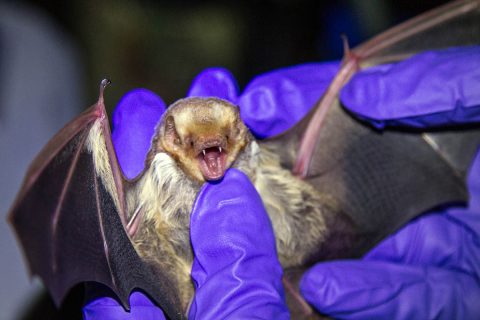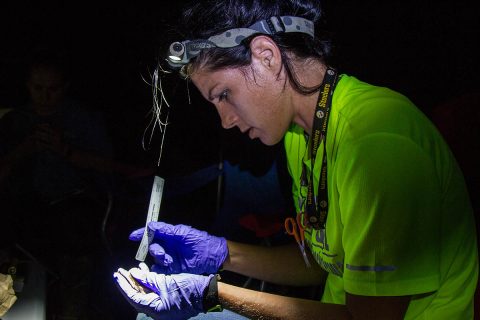Written by Sgt. Patrick Kirby
40th Public Affairs Detachment, 101st Airborne Division
 Fort Campbell, KY – As the sun sets, the humidity lets up and temperatures drop, biologists from Fort Campbell Fish and Wildlife, Environmental Division, Directorate of Public Works, are just heading into work.
Fort Campbell, KY – As the sun sets, the humidity lets up and temperatures drop, biologists from Fort Campbell Fish and Wildlife, Environmental Division, Directorate of Public Works, are just heading into work.
Their destination is Fort Campbell’s training area to do bat habitat assessments.
Anytime a tree larger than 3 inches in diameter is removed, an Endangered Species Act compliance survey must be completed.
There are two types of surveys, mist netting and Anabat. Mist nets are used by ornithologists and bat biologists to capture wild birds and bats for average counts and other projects. Anabat is an audio monitoring system that uses the ultrasonic echolocation calls of the bats for species identification and to monitor activity.

“In a typical year we’ll net 18 sites on Fort Campbell,” said Gene Zirkle, biologist, Fort Campbell Fish and Wildlife. “We do this to stay in compliance with the Endangered Species Act.”
The most common bat on Fort Campbell is the red bat.
“They’re about 80 percent of all our captures, it’s a forest dwelling bat,” Zirkle said. “Then we have the grey bat.”
Fort Campbell has two endangered species of bats, the grey bat and the Indiana bat.
The grey bat is a cave dweller that was hit hard with the white-nose syndrome.
White-nose syndrome is a deadly disease that impacts hibernating bats. The syndrome is caused by a fungus known as pseudogymnoascus destructans. The fungus grows in cold, dark and damp places and usually appears as white fuzz on the bat’s face. It attacks the hibernating bats’ bare skin and causes the infected bats to become active because it is very itchy.

This activity causes the bats to burn off the fat stores they need to survive the winter, which eventually leads to death. White-nose syndrome is highly contagious and typically is spread through bat-to-bat contact, or by humans.
“Bats are very social animals, because of this we see white-nose syndrome essentially growing from cave to cave,” Zirkle said.
White-nose syndrome was first recorded in Albany, New York, in 2006, and has spread rapidly across North America.
In efforts to support the ecosystem, installing bat boxes can create artificial roosts for bats – similar to the idea of a birdhouse.
“Residents could put up bat boxes, they have to understand though that they can’t touch the bat or look in the box, but it’s great for the bats,” Zirkle said.
Bats are an important part of the Earth’s ecosystem as they eat large amounts of insects and some are pollinators.
“Bats are a natural form of insect control,” said Morgan Torres, wildlife biologist, Fort Campbell Fish and Wildlife. “The loss of the bats will directly affect human life. If we lose our bat population, then produce prices will increase because farmers are having to spend more to kill crop damaging insects – insects that the bat would otherwise keep in check.”



